Video Gamer is reader-supported. When you buy through links on our site, we may earn an affiliate commission. Prices subject to change. Learn more
Wondering what the Diablo 4 Season 1 map size is? You’re in luck – you’ll find all the information you need right here. With a pivot to an open world, the Diablo 4 map is the largest ever weaved into Blizzard’s series’ long history. The new entry brings with it a sprawling playground rife with more foes, quests and mysteries for players to fight and uncover than ever before and over 100 dungeons. Vast, expansive, boundless, far-reaching – choose your favourite synonym, the world of Sanctuary is big.
If you’re diving into Diablo 4 and want the lowdown on what’s what in the varied topography, we’ll outline everything you need to know about the Diablo 4 map, including size, regions, and a handy explainer on the icons you’ll come across in Sanctuary. If you’re looking to explore a bit faster, check out how to get a mount in Diablo 4 and the Diablo 4 Fractured Peaks Waypoint locations to cover the early game. Check out the Diablo 4 Season Journey too as you work on the new battle pass.
Diablo 4 Season 1 map size – is it big?
Yes, Diablo 4 Season 1 has a very large map that is significantly larger and more varied than previous Diablo titles, including Diablo 3. The Diablo 4 map encompasses roughly a third of Sanctuary, covering about two-thirds of the world’s eastern landmass, making it the biggest map in the Diablo series so far. After blazing through the game as part of our Diablo 4 review, we can confirm that Fractured Peaks (the area available in several Diablo 4 beta weekends), represents about a fifth of the entire Diablo 4 map.
Unlike previous Diablo games that were sectioned off into confined, delimited areas, Diablo 4 is fully open world. Players can travel freely between all of the game’s five regions seamlessly and without loading screens via the overworld. The switch also opens the door to unique open world-geared gameplay features such as world events and world bosses – so it’ll represent a fresh, new experience for seasoned Diablo fans.
Diablo 4 Season 1 map regions
Diablo 4’s huge map size is down to it having five major regions – Fractured Peaks, Scosglen, Dry Steppes, Hawezar, and Kehjistan. These can be loosely seen as biomes with their own signature geographical features, enemy types, and overarching themes. Here’s a whistle-stop tour of each of them.
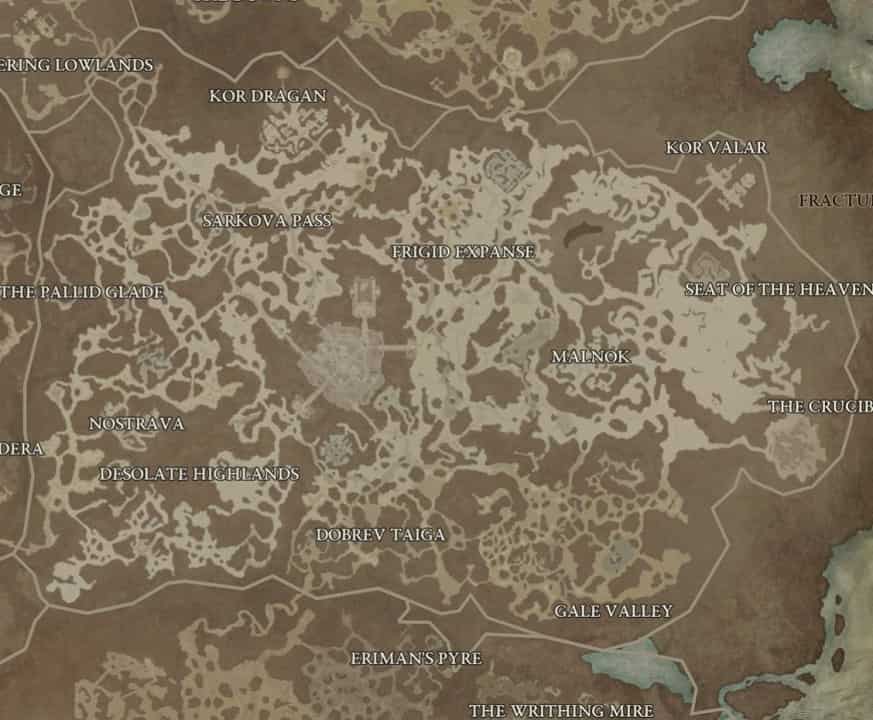
Fractured Peaks
Fractured Peaks is located in the east of the Diablo 4 map. It’s a land of icy peaks, rough rocky terrain, desolate sweeping snowfields, and eerie forests. It’s the first region you’ll visit when playing Diablo 4 and plays a major role in setting up the game’s main story campaign.
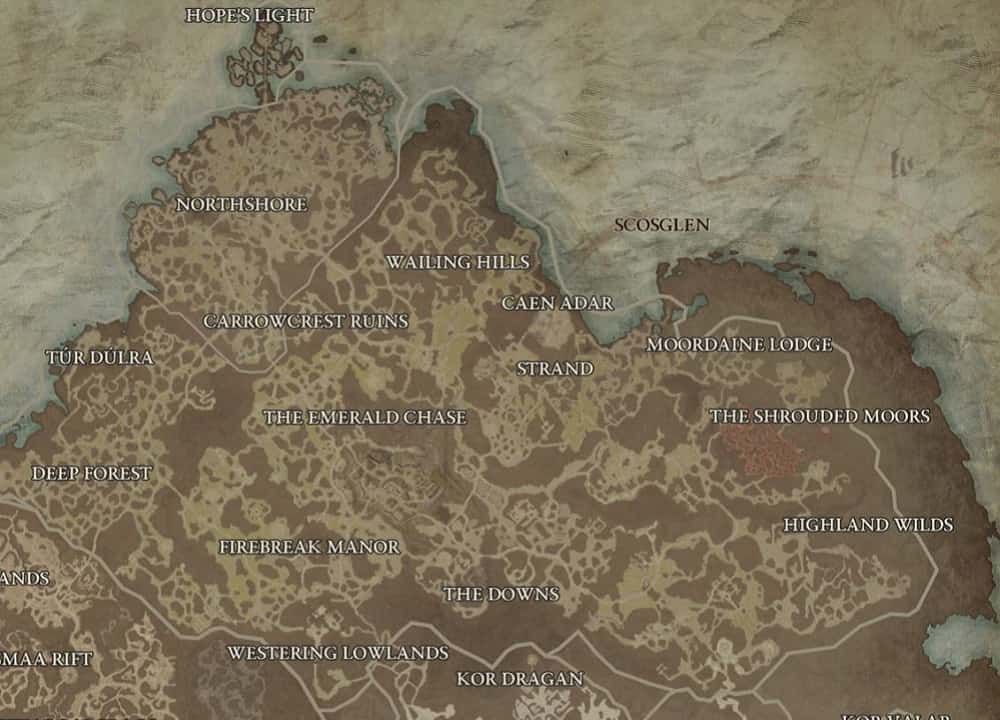
Scosglen
Covering the northern third of the Diablo 4 map, Scosglen is a verdant and tree-strewn land of bleak forests inhabited by druids and primordial wood dwellers. It’s inhospitable and hostile, and is likely the second region you’ll visit after wrapping up Fractured Peaks.
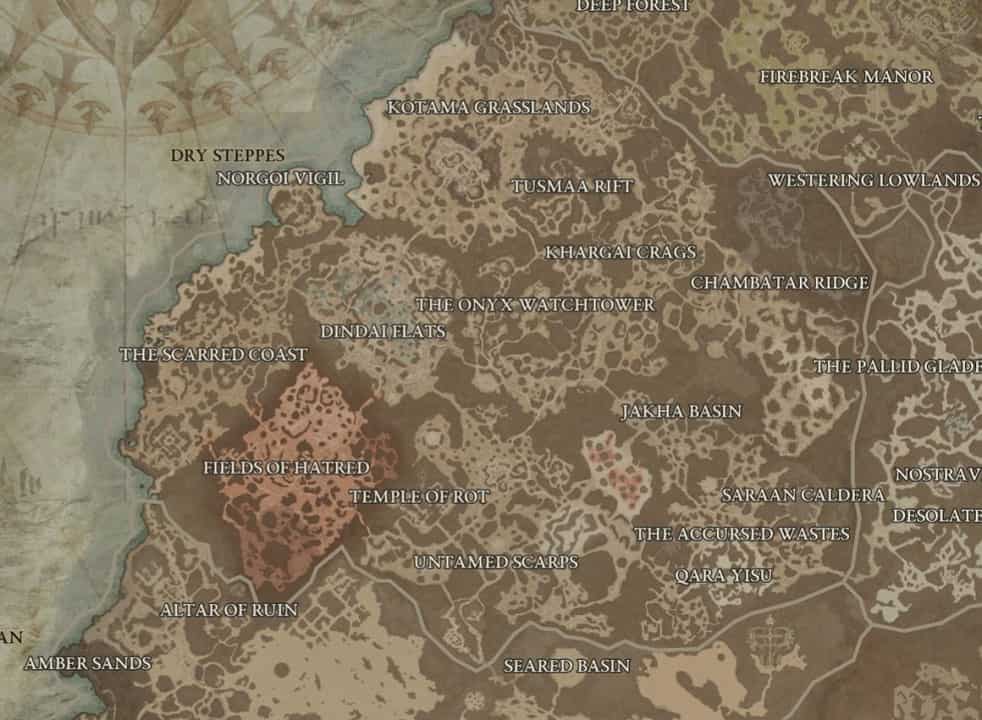
Dry Steppes
Located in the west of the Diablo 4 map, Dry Steppes lives up to its name. The steppes are harsh and rugged, lacking enough precious water to keep all those brave enough to dwell there to survive. Barbarians and mercenaries prowl the deep canyons and dry expanses more than happy to stunt the progress of any foolish enough to brave these hostile lands.
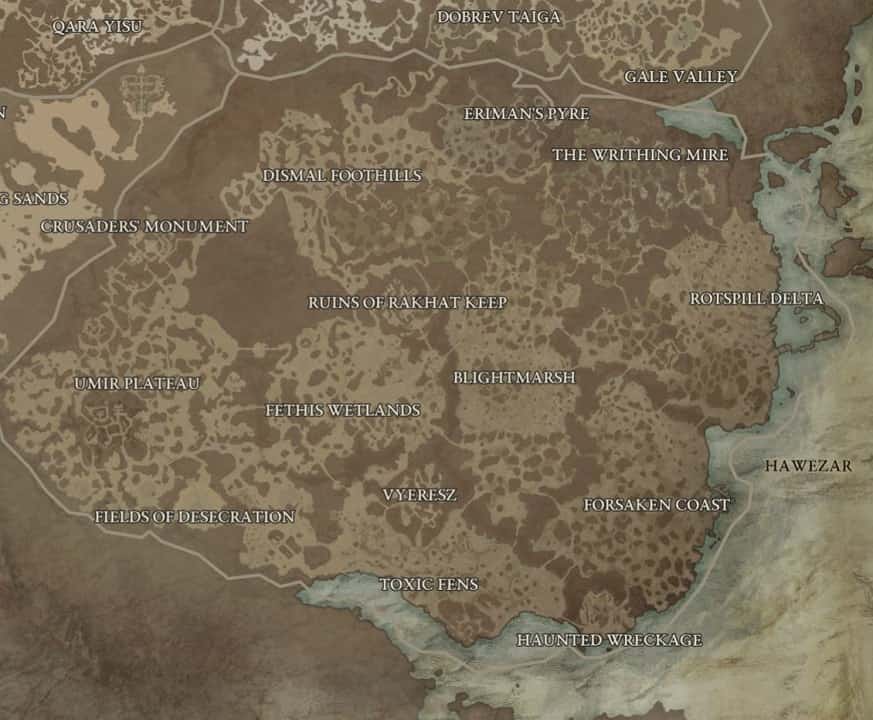
Hawezar
Nestled in the southeast of the Diablo 4 map, Hawezar is best described as a murderous swamp laced with black magic, serpent-like aberrations, and the squelchy echo of weary footsteps, a place where even the trees feel threatening. It lends itself well to the more unscrupulous portions of Sanctuary’s populace, a hotspot for thieves and cutthroats, more than happy to conceal their questionable dealings Hawezar’s ever-persistent fog.
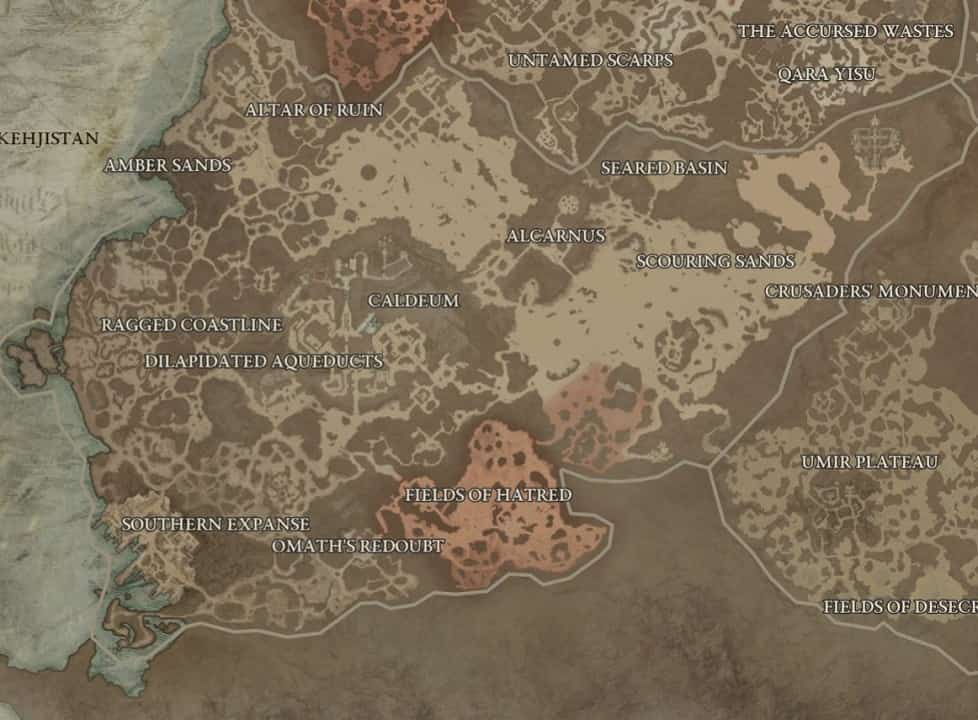
Kehjistan
Kehjistan occupies the southwestern corner of the Diablo 4 map. A desert land, Kejhistan’s sand dunes roll mercilessly beyond the horizon entrapping most who venture into them. It’s home to demons, ancestral evils, and Lilith’s tireless minions, offering little respite to travellers even in its sparse cities and small settlements.
Diablo 4 Season 1 map icons explained
Each of the Diablo 4 Season 1 map’s regions is packed with dungeons, altars, waypoints, cellars, strongholds, vendors, and shrines, which can make looking at a fully-fleshed out map overwhelming. To help you decipher all this, here’s a breakdown of the Diablo 4 map icons.
- Strongholds – Strongholds show up on the map as a red skull backed by a red roof with branches on top. These are essentially fortified areas occupied by lots of enemies and a mini-boss – defeat them to complete the stronghold.
- Waypoints – Waypoints appear on the map as a teal-coloured triangle within a circle. Waypoints are Diablo 4’s take on fast travel points and are typically found in large cities and settlements across Sanctuary.
- Altars of Lilith – Grey icons of a demon spreading its arms out denote an Altar of Lilith. Unlocking an altar gives all the characters in your realm (read account) a permanent stat boost along with a handful of renown.
- Dungeons – Side dungeons appear on the map as a white arched iron gate icon. Like side quests, these are entirely optional but are an effective way to gain experience and pick up valuable loot.
- World Tier Statues – A white icon of a circle with a cross inside that resembles a compass with slanted, jagged edges. Interact with a World Tier statue to change the World Tier difficulty level.
- Wardrobe – Wardrobes show up on the map as a white two-doored cabinet icon. Visit a Wardrobe to transmog your gear and change your character’s appearance.
- Shrines – Shrines appear on the map as a white plinth monument icon. Interacting with a shrine grants your character a short-term buff.
- Healing Well – Healing Wells are shown on the map as a white heart above a bowl. Interact with a Healing Well to replenish your health and healing potions.
- Stash – Represented by a chest icon. Here you can stow away gear and weapons for use later on if you’re running out of inventory space.
- Vendors – These show up on the map with icons depicting their activity or wares. For example, the Blacksmith is a hammer and anvil icon, while the stable is a horse head.
- Scalable cliffs and walls – these appear on the map as a set of one or two arrows. These denote shortcuts, which when interacted with has your character climb up an obstruction like a cliff face.
- World Events – An orange triangle with dots on all three faces represent World Events. As you approach, the icon turns to an orange ring indicating where the World Event takes place.
That covers everything you need to know about the Diablo 4 Season 1 map. Check out our Diablo 4 renown explainer guide to learn how finding points of interest and uncovering the map grants some handy rewards. This is even more important in Season 1 as you’ll have to start over with a Seasonal character.
As a part of the world of Sanctuary, new regions could arrive over time with their own perils. Does Diablo 4’s open-world approach work? We think it does. The new Diablo 4 battle pass also makes the most of these open spaces. We also have a guide detailing what to do at faded plaques in Diablo 4 dotted throughout Sanctuary.

